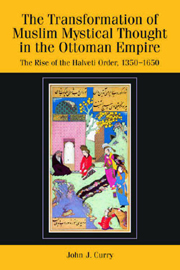 The Transformation of Muslim Mystical Thought in the Ottoman Empire
The Transformation of Muslim Mystical Thought in the Ottoman Empire Book contents
- Frontmatter
- Contents
- List of Maps and Figures
- Abbreviations for Frequently Cited Works in the Text
- Acknowledgments
- Note on Transliteration
- Map 1
- Map 2
- INTRODUCTION: ON THE STUDY OF OTTOMAN MYSTICAL TRADITIONS
- PART I THE RISE AND SPREAD OF THE HALVETİ ORDER FROM ITS ORIGINS THROUGH THE ELEVENTH/SEVENTEENTH CENTURY
- PART II THE EVOLUTION OF A HALVETİ SUB-BRANCH: THE LIFE AND CAREER OF ŞAcBÂN-I VELİ AND HIS FOLLOWERS IN THE KASTAMONU REGION
- PART III DEFENDING THE CULT OF SAINTS IN ELEVENTH/SEVENTEENTH-CENTURY KASTAMONU: TRANSFORMING THE ŞAcBÂNİYE ORDER UNDER cÖMER EL-FUɔÂDÎ
- INTRODUCTION
- 6 cÖMER EL-FUɔÂDÎ AS SUFI ASPIRANT AND HAGIOGRAPHER: THE ROAD TO ŞAcBÂNİYE SUCCESSION
- 7 INSCRIBING THE ŞAcBÂNİYE ORDER ONTO KASTAMONU'S LANDSCAPE
- 8 THE POLITICAL AND DOCTRINAL LEGACY OF cÖMER EL-FUɔÂDÎ
- CONCLUSION: WHAT CAN THE ŞAcBÂNİYE TEACH US ABOUT TRANSITIONS IN THE EARLY MODERN PERIOD OF WORLD HISTORY?
- Appendix I
- Appendix II
- Works Cited and Further Reading
- Index of Persons
- Index of Places
- Index of Subjects
8 - THE POLITICAL AND DOCTRINAL LEGACY OF cÖMER EL-FUɔÂDÎ
from PART III - DEFENDING THE CULT OF SAINTS IN ELEVENTH/SEVENTEENTH-CENTURY KASTAMONU: TRANSFORMING THE ŞAcBÂNİYE ORDER UNDER cÖMER EL-FUɔÂDÎ
Published online by Cambridge University Press: 12 September 2012
- Frontmatter
- Contents
- List of Maps and Figures
- Abbreviations for Frequently Cited Works in the Text
- Acknowledgments
- Note on Transliteration
- Map 1
- Map 2
- INTRODUCTION: ON THE STUDY OF OTTOMAN MYSTICAL TRADITIONS
- PART I THE RISE AND SPREAD OF THE HALVETİ ORDER FROM ITS ORIGINS THROUGH THE ELEVENTH/SEVENTEENTH CENTURY
- PART II THE EVOLUTION OF A HALVETİ SUB-BRANCH: THE LIFE AND CAREER OF ŞAcBÂN-I VELİ AND HIS FOLLOWERS IN THE KASTAMONU REGION
- PART III DEFENDING THE CULT OF SAINTS IN ELEVENTH/SEVENTEENTH-CENTURY KASTAMONU: TRANSFORMING THE ŞAcBÂNİYE ORDER UNDER cÖMER EL-FUɔÂDÎ
- INTRODUCTION
- 6 cÖMER EL-FUɔÂDÎ AS SUFI ASPIRANT AND HAGIOGRAPHER: THE ROAD TO ŞAcBÂNİYE SUCCESSION
- 7 INSCRIBING THE ŞAcBÂNİYE ORDER ONTO KASTAMONU'S LANDSCAPE
- 8 THE POLITICAL AND DOCTRINAL LEGACY OF cÖMER EL-FUɔÂDÎ
- CONCLUSION: WHAT CAN THE ŞAcBÂNİYE TEACH US ABOUT TRANSITIONS IN THE EARLY MODERN PERIOD OF WORLD HISTORY?
- Appendix I
- Appendix II
- Works Cited and Further Reading
- Index of Persons
- Index of Places
- Index of Subjects
Summary
The final years of cÖmer el-Fuɔâdî's life were marked by religious and political tensions in the Ottoman Empire present since the time of its foundation, and his contemporaries came to note him as a central figure in the debates that caused those tensions. Therefore, to a great extent, any assessment of his life and legacy must be grounded in the context of his polemical response to the religio-political crisis revolving around Muslim mysticism. The crisis was best symbolized by the intractable debate over the legitimacy of the Halveti semâc, chanted litanies set to musical accompaniment, and devrân, the circular motions that went with it that sought to bring the seekers into a mystical state. The debate over these practices had ancient roots, but had usually not taken on the form of a lengthy and sustained campaign against them. But by Fuɔâdî's time, the level of aggression and hostility over the issue had risen significantly.
To a modern observer the debate appears quaint or eccentric. Some might liken it to the Byzantine debate over Iconoclasm, sometimes interpreted as an obscure doctrinal dispute that had little relevance to the Byzantine Empire's very real problems in staving off Arab and Bulgarian invasion. Nevertheless, a closer examination of the underlying issues suggests that there was more to the semâc/devrân conflict than hair-splitting clashes between theologians and mystics. Instead, the very foundations of Ottoman religious law was at stake.
- Type
- Chapter
- Information
- The Transformation of Muslim Mystical Thought in the Ottoman EmpireThe Rise of the Halveti Order, 1350–1650, pp. 268 - 291Publisher: Edinburgh University PressPrint publication year: 2010


